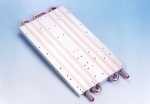SOLUTIONS & SERVICES
Solutions & Services
Joining of Aluminum

Aluminum can bonded using S-Bond® alloys and is an excellent alternative aluminum joining processes. Cycle times may be reduced and, especially with thermally sensitive applications or low piece lots, the limited tooling and ease of set up for S-Bond joining can significantly reduce costs.
Active S-Bond® solders easily react with and break through the oxide layers on aluminum and copper to react quickly and irreversibly with the metal without the use of plating or fluxes, thus lowering the cost of solder joining aluminum and also eliminating aggressive chemicals that create environmental hazards. Additionally, S-Bond’s low joining process temperature (typically below 250ºC) preserves the hardness and strength of the base aluminum making the finished component more robust.
There are a range of S-Bond alloys available with different service temperatures from 100°C to 390°C. These same products also join well to copper, aluminum silicon carbide, and other thermal management materials and allow cost effective, fluxless assembly of complete thermal management systems.
S-Bond® can be an alternative aluminum joining process to welding or brazing where low temperature joining is required and the service or stress service environment would permit a soldered joint. S-Bond is very effective in soldering aluminum to aluminum as well as soldering aluminum to copper. In some cases, S-Bond joining can replace controlled atmosphere brazing or “dip brazing”.
Active S-Bond® solders react with and break through the oxide layers on aluminum and also with copper to react quickly and bond with the metal without the use of plating or fluxes, thus lowering the process cost of soldering aluminum or aluminum-copper components and also eliminating aggressive chemicals that create environmental hazards. Additionally, S-Bond’s low joining process temperature (typically below 250ºC) preserves the hardness and strength of the base aluminum making the finished component more robust.
Advantages of S-Bond Aluminum Joining
- Lower temperature bonding (from 120 – 250°C) lowers thermal expansion mismatch issues.
- Permits the joining of aluminum to copper and other metals and ceramics, provided thermal expansion mismatch is managed in the component design.
- An S-Bond metallic solder joint provides thermally conductive bonded interfaces
- No additional metal plating is required to prepare aluminum surfaces, lowering preparation costs.
Aluminum structures are normally brazed, welded or soldered. Braze joining of aluminum uses Si-rich Al alloys that have brazing temperatures ~ 25 – 50 ºC below the melting points of the base aluminum. Additionally, to disrupt the aluminum oxides that form naturally on aluminum, aggressive chemical fluxes and/or vacuum furnaces must be used for bonding aluminum. As such, aluminum brazing in furnaces requires precise controls and atmospheres. After brazing, the high processing temperature considerably softens and lowers the base aluminum strength.

S-Bond an Alternative to Brazing
S-Bond can be an alternative lower temperature joining process and replace brazing in some applications. S-Bond is very effective in soldering aluminum to aluminum as well as soldering aluminum to copper. In many cases, “dip brazing” is also used in joining aluminum. Dip brazing uses similar Si-rich aluminum filler metals and pre-places performs or aluminum pastes with chemical fluxes into a salt bath that heats the aluminum components which have been fixtured to hold the part positions in the bath. As in furnace brazing, the high temperatures of the brazing process soften the base aluminum and the parts must be rinsed of the flux and salt that comes from the bath exposure. Due to the aggressiveness of the chemicals and salts, work environment and waste disposal issues are now limiting available dip brazing sources.
Contact us for more information on the joining of aluminum or to navigate to our Technical Resources section and Blog for more information.
More Information?
If you would like someone to contact you or provide information, please submit the information to the right.
